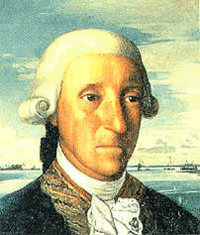Domingo de Bonechea

Domingo Bernardo de Bonechea Andonaegui (Basque: Domingo Bonetxea Andonaegi), born on August 8, 1713, in Getaria, Basque Country, Spain, died in Tahiti in 1775, was a captain in the Spanish Royal Navy and an explorer for the Spanish crown. He is known for having tried to incorporate Tahiti to the Spanish seaborne empire.
His father, Juan Bauptista de Bonechea Aramburu (1685–1770), commanded the fishing vessel Terranova off Nova Scotia in 1727 and became a captain in the Spanish Royal Navy; his uncle Francisco de Bonechea Aramburu was a frigate captain. His mother was Francisca Andonaegui Narbasta; the parents married on 25 March 1714, a few months after Domingo's birth. His younger brother Francisco Bonechea Andonaegui was also a naval officer, mentioned as a lieutenant aboard one of the frigates that escorted Carlos III from Italy to Spain in 1759 on his accession to the Spanish throne.
Domingo de Bonechea Andonaegui did not pass through naval college or formal navigational studies. He served in the Spanish navy as a pilot from 1732 to 1740, when he became midshipman (Alferez) of a frigate. He took part in the Battle of Toulon (22/23 February 1744) He was promoted to Mishipman of a Ship of the Line in 1749 and to Frigate lieutenant in 1751.
In 1754 he was promoted to lieutenant of a ship of the line. His first command seems to have been the Corvette Marte (18)in which he took part in the action in which Spain lost Havana to the British Admiral Pocock in 1762. After a desperate action against the British Captain George Mackenzie he surrendered at Mariel. He was exonerated of all blame and acquitted with honour.
In 1766 he became a frigate captain and from 1767 commanded the frigate Santa Maria Magdalena, afterwards renamed Aguila. Together with the Lievre, he took supplies to the Falkland Islands and reached the port of Concepcion (Chile) on 14 April 1768. From there he continued on to Callao (Peru) and seems to have remained in the region for several years.
Domingo de Bonechea's exploratory voyages were commissioned by the Viceroy of Peru, Manuel de Amat y Juniet, who was concerned that Captain Cook's explorations might lead to the creation of British bases from which to attack Peru. De Bonechea reached Tahiti only weeks after Cook's First Voyage, and indeed found an axe left there by Cook's expedition. He recorded a great many local native words.
First voyage (1772–1773)
On September 26, 1772, de Bonechea went on an exploratory expedition to Tahiti. He sailed with Tomás Gayangos as his lieutenant on the Aguila from Callao harbour, Peru. The expedition reached Tahiti on November 13. He anchored opposite Tautira village which de Bonechea christened "Santísima Cruz". De Bonechea forbade himself and his crew any sexual relations with local women, which surprised the Tahitians greatly. He left Tahiti on December 20 and reached Valparaíso on February 21, 1773.
Georg Forster, who accompanied Cook on his Second Voyage, refers to him as "Domingo Buenechea".
Second Voyage (1774–1775)
The aim of this expedition was the annexation of Tahiti to the Spanish crown, with the approval and encouragement of King Carlos III, and to convert its inhabitants. Two ships, the Aguila and the Jupiter left Callao on September 20, 1774. After winning over Tu, the most important king of the Tahitians, de Bonechea's men were allowed to establish a mission. However, de Bonechea died on January 20, 1775, in Tahiti, where his grave, which had been dismantled on Captain Cook's orders, was rediscovered in the 20th century in the village of Tautira.
The Spanish mission on Tahiti was abandoned on November 12 the same year and the whole enterprise came to an early end.
See also
- Buenechea Regarding his family name.
- Tahanea & Tatakoto, two atolls visited by Domingo de Bonechea before any other recorded European mariner.
References
- "The 18th Century Sailors", Tahiti Guide.
- Amaru, G. "Tahití hubiera podido ser española", Vivat Academia, No. 1 (Dec. 2005-Jan. 2006).
- Colaboradores de Wikipedia. "Expediciones españolas a Tahití", Wikipedia, La enciclopedia libre.
- Ortiz Sotelo, Jorge. "Expediciones peruanas a Tahití, siglo XVIII." Derroteros de la Mar del Sur, No. 13 (2005), 95-103.
- Riullop, Vicenç. La isla anacreóntica: Las referencias clásicas de los navegantes de la Ilustración. 2004.